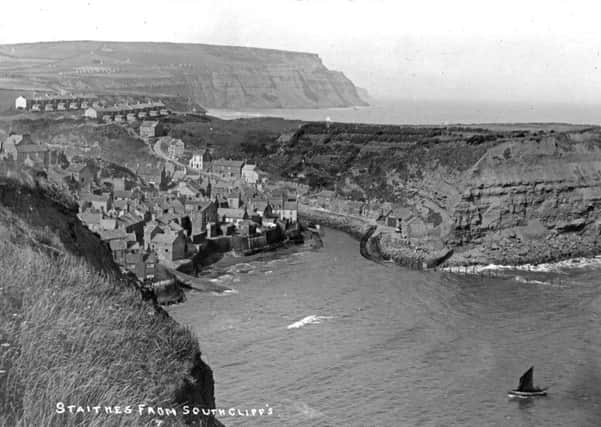Nostalgia on Tuesday: Happy landing


Its name means ‘landing place’ and, from early times, probably gave access to the adjacent cliff- top settlements of Seaton and Hinderwell. Research indicates that Staithes may have been developed on the remains of a 12th-15th-century fortified site.
The village, now a popular tourist destination, lies within the North Yorkshire Moors National Park and includes a conservation area.
Advertisement
Hide AdAdvertisement
Hide AdWithin the conservation area are about 81 listed buildings grouped around small yards, narrow streets and passageways. These, and a number of others, date from the 18th and 19th century and include cottages built of stone. Later, buildings constructed from brick nod towards Staithes’s later links with mining and the coming of the railway.
Staithes is not mentioned in the Domesday survey of 1086 because it did not exist as a village. Once established, growth eventually came and was due to rich mineral reserves, development as a port and a strong link with fishing.
A short distance to the west, on cliffs above Staithes, was Boulby Alum Works operating between the late 17th century and late 19th century. It brought jobs and prosperity to Staithes – the workforce included both men and women, as well as boys aged over 12.
Alum shale was usually extracted from quarries on steep inland hillsides or coastal cliffs. The Boulby Alum Works was one of the most productive and long-lived in the region, started by the Conyers family of Boulby Manor.
Advertisement
Hide AdAdvertisement
Hide AdAlum, a colourless crystal, was manufactured from alum- bearing rock discovered at nearby Guisborough in 1600.
The material underwent a long, complicated development before it was of use to the textile, tanning and paper industries. Among the processes was the burning of seaweed to create kelp, some of the tasks being undertaken by women on Staithes’ beach. Delivering bulky raw materials and taking the alum away to markets, mainly in London, was done by boat. A decline in the alum industry began from 1855 due to cheaper and different processes being introduced.
Captain James Cook, born in Marton, near Middlesbrough, moved to Staithes at the age of 16 from 1745 -1746. Working as an apprentice for Staithes grocer William Sanderson, he eventually moved to Whitby and joined the Royal Navy, beginning an adventurous maritime career.
Sanderson’s shop was destroyed by the sea, but parts were recovered and incorporated into ‘Captain Cook’s Cottage’, which has been the home of a local family for many years. A heritage centre on the High Street contains memorabilia and artefacts associated with Cook, besides a recreation of the grocer’s shop where he once worked.
Advertisement
Hide AdAdvertisement
Hide AdStaithes was a thriving port from about 1750 until c. 1880. Many boat owners were resident in the area and ran merchant ships and fishing boats. The size of the ships varied from large 400-ton vessels or barques to smaller 40-ton sloops. Employment was boosted by the presence of boat-builders, sail-makers, hook-makers, fish-curers and fish merchants.
Jet mining was prevalent, on a small scale, in Staithes during the latter half of the 19th century, affording locals with a modest living from the creation of jewellery. A number of ‘jet miners’ dangerously worked the cliffs. They were lowered by rope over a precipice, and cleared away a section of the cliff for the jet ‘seam’ to be revealed. The material was then completely removed.
Decline in production may be assigned to Queen Victoria ceasing to wear jet jewellery after her period of mourning for Prince Albert’s death.
Staithes began involvement with ironstone mining from the mid-19th century until the dawn of the 20th century. After the ironstone reserves dwindled at Port Mulgrave, another mine was opened a short distance inland at Grinkle. The material was carried on a narrow gauge railway running over three wooden viaducts and through two tunnels to reach the harbour, though this route was later abandoned.
Advertisement
Hide AdAdvertisement
Hide AdStaithes joined the railway network from December 3, 1883, when a railway station opened on the Whitby, Redcar and Middlesbrough Union Railway. The lines passed over the Staithes viaduct, built in 1875 but not opened until the rest of the railway. Built of iron and concrete, the viaduct was 152ft high and 790ft in length. When there were strong winds in the area, trains could only cross at 20 miles per hour, and the viaduct was closed completely in high winds.
The viaduct was demolished in 1960 and a plaque near the former site, details its history as well as that of the railway. Staithes railway station is now a private residence.
The Staithes Group of artists, who pursued their own version of Impressionism, were active in the village between 1894 and 1909 and included Frederick W Jackson, Edward E Anderson and the married couple of Harold and Laura Knight, who kept a studio in Staithes.
Laura Knight in her autobiography Oil Paint and Grease Paint (1941) stated: ‘Staithes...It was there that I found myself and what I might do. The life and place were what I yearned for – the freedom, the austerity, the savagery, the wilderness. I loved the cold and the northerly storms when no covering would protect you. I loved the strange race of people who lived there, whose stern almost forbidding exterior formed such contrasts to the warmth and richness of their nature’.
Further reading: A History and Geology of Staithes (1998), Jean and Peter Eccleston.